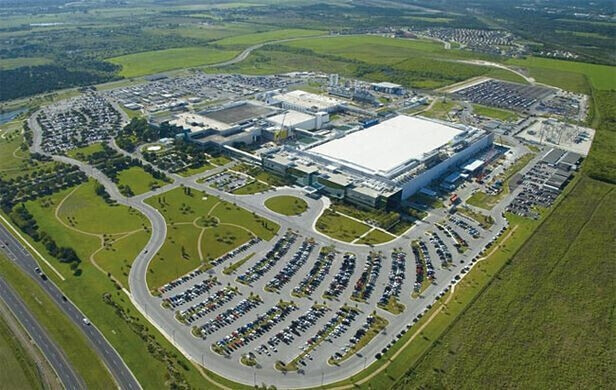hankyoreh
Links to other country sites 다른 나라 사이트 링크
US-China trade war fuels S. Korea-Taiwan chip competition in US

Since the start of the US-China trade war, the gap between Korea and Taiwan in the US import market has narrowed, while the two countries’ export similarity index has increased. This is the result of intensifying competition between Korea and Taiwan in the semiconductor sector.
The gap between Korea and Japan in the automobile sector has also been narrowing.
According to a report released by the Korea International Trade Association (KITA) Tuesday, Korea, Vietnam and Taiwan have seen rising shares in the US import market between 2017 and 2021, during which the gap between Korea (3.05%→3.35%) and Taiwan (1.81%→2.72%) decreased from 1.24 percentage points to 0.63 percentage points.
The export similarity index between Korea and Taiwan rose from 0.351 in 2017 to 0.373 in 2021, indicating escalating competition. The export similarity index assesses the degree of competition between two countries in a particular market by quantifying the similarity of the structures of export products. The closer the index is to 1, the more intense is the competition.
In the same time frame, China (21.59%→17.84%) and Japan (5.83%→4.76%) saw a decrease in shares by 3.76 percentage points and 1.07 percentage points, respectively, as well as falling ESIs in respect to Korea.
Meanwhile, Vietnam’s share increased by 1.61 percentage points from 1.99% to 3.60% during the same period, the largest increase among the five major Asian countries. Vietnam (3.41%) overtook Korea (3.26%) in US import market share for the first time in 2020. The report, however, evaluated that Vietnam and Korea’s ESI (0.189) was low due to differences in the structure of major export items.
The semiconductor sector is largely responsible for the intensifying competition between Korea and Taiwan. While US imports of Chinese semiconductors plunged during the past five years through 2021, Korea and Taiwan’s share in the semiconductor sector increased by 5.34 points and 3.82 points, respectively, and the ESI between the two countries rose from 0.480 to 0.575.
“This is due to the transition from importing Chinese memory modules to importing Korean and Taiwanese modules following the US’ introduction of additional tariffs on China in 2018,” explained KITA.
US imports of semiconductors from China fell from US$12.5 billion in 2017 to US$3.59 billion in 2021.
The gap in US import market share between Korea and Japan has decreased from 10.54 percentage points in 2017 to 6.84 percentage points in 2021. The automobile sector largely accounts for the decrease.
As of 2021, Japan’s market share was 15.25% and Korea’s was 8.41%. In the first half of 2022, the gap in market share narrowed down to 5.03 points, with Japan’s share hitting 13.6% and Korea’s hitting 8.57%.
KITA explained the change as owing to “diversification in auto models with more SUVs, which are high value-added vehicles, and strong premium brand sales.”
By Kim Young-bae, senior staff writer
Please direct questions or comments to [english@hani.co.kr]

Editorial・opinion
![[Column] Season 2 of special prosecutor probe may be coming to Korea soon [Column] Season 2 of special prosecutor probe may be coming to Korea soon](https://flexible.img.hani.co.kr/flexible/normal/500/300/imgdb/original/2024/0426/3317141030699447.jpg) [Column] Season 2 of special prosecutor probe may be coming to Korea soon
[Column] Season 2 of special prosecutor probe may be coming to Korea soon![[Column] Park Geun-hye déjà vu in Yoon Suk-yeol [Column] Park Geun-hye déjà vu in Yoon Suk-yeol](https://flexible.img.hani.co.kr/flexible/normal/500/300/imgdb/original/2024/0424/651713945113788.jpg) [Column] Park Geun-hye déjà vu in Yoon Suk-yeol
[Column] Park Geun-hye déjà vu in Yoon Suk-yeol- [Editorial] New weight of N. Korea’s nuclear threats makes dialogue all the more urgent
- [Guest essay] The real reason Korea’s new right wants to dub Rhee a founding father
- [Column] ‘Choson’: Is it time we start referring to N. Korea in its own terms?
- [Editorial] Japan’s rewriting of history with Korea has gone too far
- [Column] The president’s questionable capacity for dialogue
- [Column] Are chaebol firms just pizza pies for families to divvy up as they please?
- [Column] Has Korea, too, crossed the Rubicon on China?
- [Correspondent’s column] In Japan’s alliance with US, echoes of its past alliances with UK
Most viewed articles
- 1AI is catching up with humans at a ‘shocking’ rate
- 2Korea’s 1.3% growth in Q1 signals ‘textbook’ return to growth, says government
- 3[Column] Park Geun-hye déjà vu in Yoon Suk-yeol
- 4No good, very bad game for Korea puts it out of Olympics for first time since 1988
- 5[Column] Season 2 of special prosecutor probe may be coming to Korea soon
- 6[Column] Has Korea, too, crossed the Rubicon on China?
- 7Division commander ordered troops to enter raging flood waters before Marine died, survivor says
- 8Is Japan about to snatch control of Line messenger from Korea’s Naver?
- 9Marriages nosedived 40% over last 10 years in Korea, a factor in low birth rate
- 101 in 5 unwed Korean women want child-free life, study shows